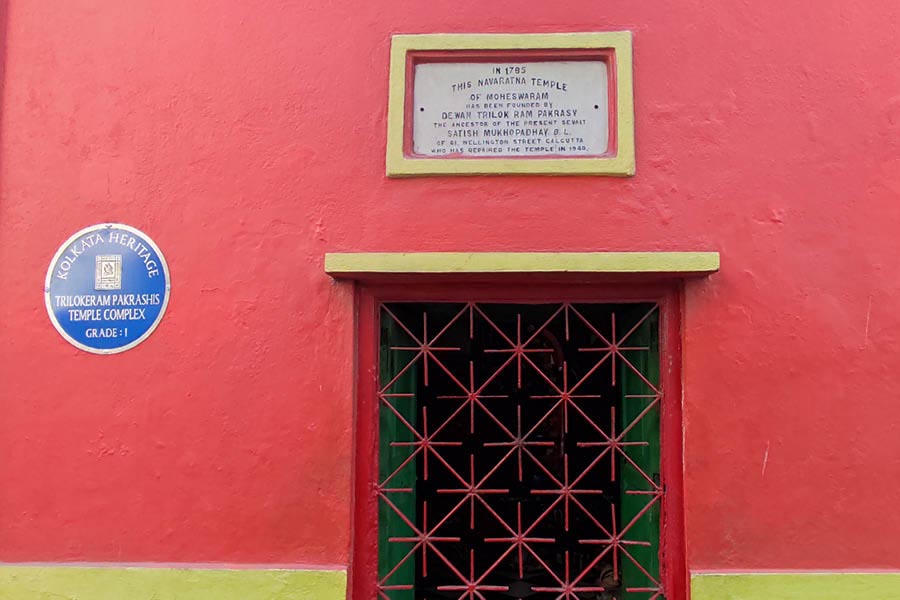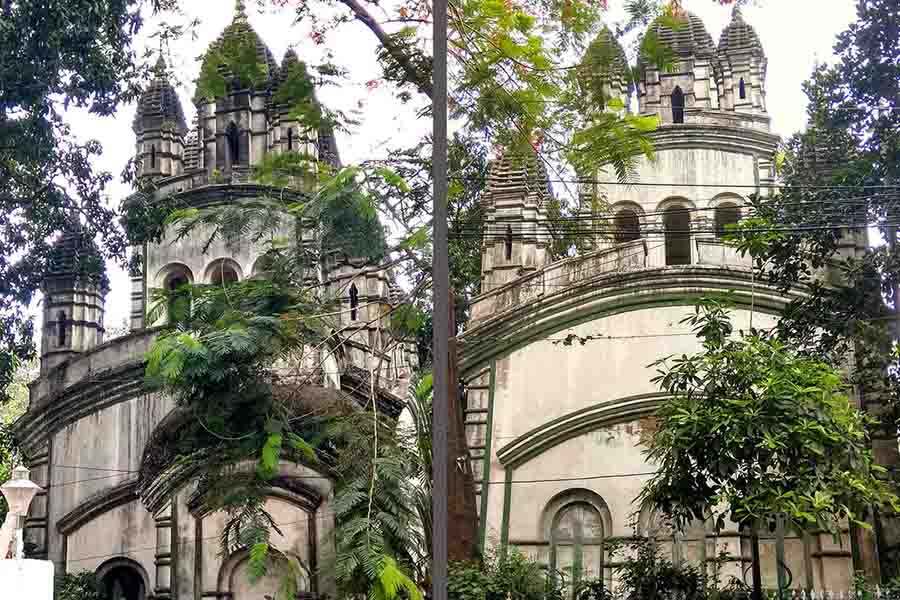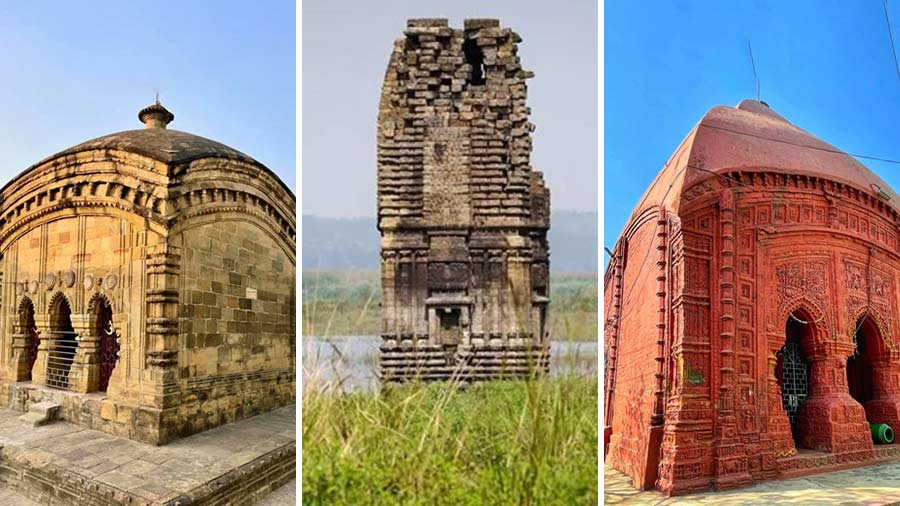Similar to the Nabaratna Temple of Bhabatarini located at Balaram Ghosh Street, there is another Nabaratna temple built in the heart of the city in central Kolkata with two Pancharatna temples beside it inside one of those innumerable narrow lanes. The aforesaid street has a rather uncommon name — Kenderdine Lane. Originating from BB Ganguly Street, just adjacent to the well-known hall of Bharat Sabha or Indian Association, the narrow Kenderdine Lane is nondescript lane in Bowbazar. Its name was changed to Bharat Sabha Path on November 10, 1999, but it still goes by its old name.
As mentioned in PT Nair’s book, A History of Calcutta’s Streets, the lane is named after George Mainwaring Kenderdine alias GM Kenderdine, a surgeon who was in charge of what was Kolkata’s first mental asylum for European patients.

The plaque installed by the West Bengal Heritage Commission adorns the complex wall.
The only highlight of this narrow pathway are three temples standing side by side perpendicular to the lane. It is interesting to note that the temple complex at 18/1, Kenderdine Lane, has been designated as Grade I Heritage Structure by the West Bengal Heritage Commission and its blue plaque is visible on the wall of the temple facing the lane. Despite being a Grade I Heritage Structure, the temples are encroached from all sides by contemporary tall buildings. It is impossible to view all three temples at one go from the street. The only option is to climb to the terrace of the adjoining mansion and look down for a complete view of the three temples.
The deities of all three temples are Shiva lingams. They are worshipped daily. The three temples with ridged pinnacles are painted in red. The navaratna-styled temple, which stands at the centre is known as Moheswaram Shiva temple as per a plaque on the wall of the Pancharatana Shiva temple located beside the lane. The plaque also mentions that the navaratna-styled temple was built in 1785 by dewan Trilok Ram Pakrasy. In the book Kolkatar Mandir o Masjid by Tarapada Santra, the other two Pancharatna temples have been referred simply as Shiva temples having been constructed in the same year.
The most interesting part of such temples are their pinnacles. In Hindu temple architecture, a ratha is a facet or vertical offset projection on the plan of a structure. Usually a temple may have tri ratha (three facets), pancha ratha (five facets) and sapta ratha (seven facets), etc. A ratha is generally carried up from the bottom of the temple to the superstructure, but interestingly here each pinnacle is designed like a small temple with tri-ratha projections on all four sides. The design of the pinnacle shows much influence of the nagara-styled shikhara which originated in northern India. The two Pancharatna temples have four small pinnacles on its four corners with a fifth large pinnacle at the centre. The Nabaratna temples also have four small pinnacles on its four corners and a miniature Pancharatna-shaped structure on its centre. On top of each pinnacle there is a metal finial. Usually seen at the top of the pinnacle, these are ornamentations designed in the form of various kinds of trishul.

As mentioned in PT Nair’s book, ‘A History of Calcutta’s Streets’, the lane is named after George Mainwaring Kenderdine alias GM Kenderdine, a surgeon who was in charge of what was Kolkata’s first mental asylum.
As per the book Kolkata Ekaler o Sekaler by Harisadhan Mukhopadhyay, dewan Trilok Ram Pakrasy built these temples at the time when the new Fort William was being constructed. Pakrasy was employed in the capacity of dewan of Fort William. He was in charge of supply of labour and building materials for the new Fort William building. He also used to supervise the construction work. Trilok Ram made a huge fortune from his profession. There is an urban legend that the bricks used in constructing the temple were of similar type as was used in constructing the walls and ramparts of Fort William.
Apart from Trilok Ram, there was also a Bengali contractor, who was entrusted with the contract of building the fort. He was Durga Pituri of Bowbazar, who also amassed wealth from his business.
According to another plaque in front of the temple dewan Trilok Ram Pakrasy died in 1796. His daughter, Sarbamangala Devi, was married to Raghunath Mukhopadhyay of 61, Wellington Street. Their descendants are at present in charge of these three temples. The best time to visit these temples are in the morning hours, between 9 and 10.30.




